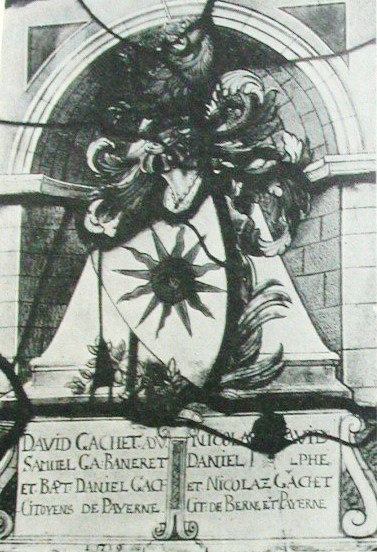

Both the Gachet family of Payerne and their descendants the Gatschet family of Bern are now extinct. When the last of these Gatschets, Adèle Peyron-Gatschet, died in 1921, whatever family documents and portraits that she owned were passed to her stepson François Peyron of Grenoble, and then to his widow. At that point, about 1935, the trail goes cold.
The Noble Gachet family of Payerne had a private chapel in the parish church there. The last of that family died in 1812. In 1817, the excavations of Colonel de Dompierre in the old abbey of Payerne revealed a tomb that he thought must contain the remains of the famous Queen Berthe of Burgundy, who was supposed to have founded the abbey. (Queen Berthe's famous testament has later been determined to be a forgery from the 12th Century, and the bones are no longer believed to be those of the Queen.) The Colonel then appropriated the now vacant chapel of the Gachet family to house a proper monument to the Queen, which was dedicated with great ceremony in 1818. But as a result of this modification, the only trace of the Gachet family that remains in their ancient chapel is their arms carved at the top of the vault of the ceiling. The funeral inscriptions that were once visible on the floor of the chapel had been removed. Were the paving stones simply turned over? If so, the authentic inscriptions, as well as the bones of the Gachet family, may still exist beneath the floor of the chapel. There was also a stained glass window in the chapel bearing the names of several family members. The window seems to have been lost, but not before it was photographed for Galbreath's Armorial vaudois. The photograph shows the date 1719 (or 1716?) at the bottom of the panel. The donors of the window appear to have been David Gachet, Advoyer de Payerne (born 1659, died after 1722); Samuel Gachet , Banneret (1648-1733); and [Jean] Baptiste Daniel Gachet (son of Samuel, born about 1702, died 1762), all citizens of Payerne; and Nicolas (silversmith, 1655-1727), David (1659-1750), Daniel (Landvogt, 1694-1729), [Hans] Rodolphe (1699-1762), and Nicolas (soldier 1702-1769) Gatschet, citizens of Payerne and Berne.
The published and unpublished secondary sources for this family contain many errors. The errors probably arose when genealogists of the past speculated in order to fill in the gaps in the pedigree. One of the more enduring errors was the identity of the Magdelaine Gachet who married Samuel d'Erlach. The secondary sources are unanimous in making Magdelaine the daughter of Niklaus Gatschet of Bern, in spite of the fact that her father's personal record tells us that his daughter died as a small child. The true identity of Magdelaine, now proven to be the daughter of François Gachet, one of the brothers of Niklaus, was found in a terrier for the "noble fiefs of Lausanne".
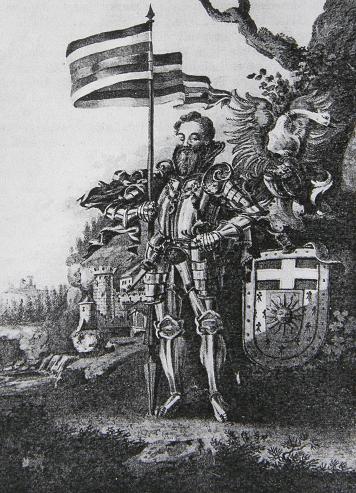
Illustration from the title page
of the manuscript "Wappenbuchs des alten
und neuen Adels" by Niklaus Gatschet, 1736-1817.
A much later Niklaus Gatschet was the author of a manuscript armorial. The cover bears a striking illustration of a knight with the Gachet arms posed in front of a castle. In other words, the illustration implies that the original Gachet participated in the Crusades. Unfortunately, the various attempts at a pedigree going back to that time disagree on many points.
The history of the family can be carried back to the early 14th Century from the records of the notaries. The Gachet of Payerne are found to be members of the Gachet family that lived at Villars-en-Vully, now known, in spite of the fact that it is and always has been a tiny village, as Villars-le-Grand. We have started to investigate the terriers of this area, in hopes that they will give enough information to allow some conclusions about the authenticity of the questionable pedigrees. The Gachet family of Villars-le-Grand has apparently died out as well, last noted in the 17th Century. The first results from the terriers have already established that the Gachet family of Grandcour came from Villars, in the person of a Jean Gachet, son of Rolet Gachet of Villars. This Jean Gachet had already died by 1526, when descendants of the family acknowledged their properties and their feudal taxes in the vicinity of Villars. Another branch of the family, apparently unnoticed and long since extinct, had settled at Le Landeron in Neuchâtel.
Niklaus Gatschet and his six brothers, all but one of whom remained in Payerne, divided their inheritance in 1560. They had held the property from their father Pierre Gachet jointly and in common ever since his death in 1529. We found the record of the settlement, but not the detailed list of the properties themselves. Depending on the nature of the property, it seems likely that they must have had a "terrier" or "rentier" that detailed the income that should have been collected from their tenants. At least some of the property must have come from their mother Jaquaz de Torculari (modern Dutruict), who was a half-sister of the famous Peter Falck of Fribourg. In later records in the vicinity of Lutry, there are a couple references to members of a Dutruict family who were cousins of François Gachet.
The traditional origins of the Gatchet family mentioned above refer to a castle in the vicinity of Coppet, long since destroyed, at a place still called Gachet. There are occasional references to the surname Gachet in that area as late as the 16th Century, but nothing to indicate that they have any connection either with a castle or with the Gachet families of Payerne or Villars-le-Grand. There are also Gachet families at Bioley-Orjulaz and Grandcour (see above, this family can now be connected with the one at Villars), and a "Gatschi" family at the neighboring villages of Erlach (this village called Cerlier in French) and Ins (this village called Anet in French) in the Canton of Bern that may or may not be connected to the family of Payerne. A Gachet family of Gruyère (Canton of Fribourg) from a very early date does not seem to be connected to any of these families. There does not seem to be any documentation linking any of these families to any of the others, except for the families currently known to have originated in Villars. The most definitive way to prove the connections would involve DNA samples. The analysis would be far more interesting if we could dig up the bones of the ancient Gachet of Payerne or Bern, but first we would have to find the bones!
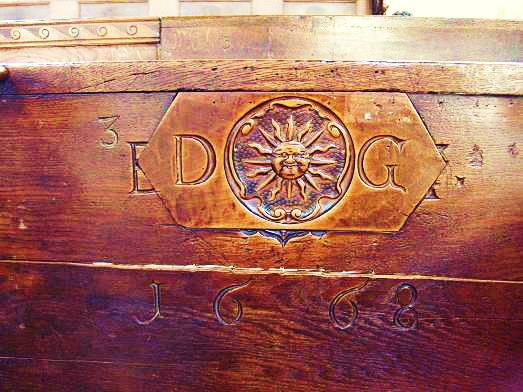
By the 19th Century, the "Gatchi" family of Erlach and Ins had largely adopted the spelling Gatschet, and one branch successfully applied for citizenship in the city of Bern. To this family belongs the famous linguist and ethnologist Albert Samuel Gatschet (1832-1907).
Recently, Catherine Minck noticed a carved pew in the cathedral at Bern bearing the Gachet arms and the initials DG. There may be other artifacts still to be discovered. In particular, we can't help but wonder if the floor of the old Gachet chapel, reworked when the monument holding the supposed bones of Queen Berthe was installed, still conceals one or more Gachet burials.
The genealogy of the Gachet, their ancestors, their descendants, and their relatives, with transcripts and extracts from many of the original documents, can be found in our database on the Dutoit family. The simplest path into the Gachet and Gatschet material in the database is to navigate to the entry for Pierre Gachet (died 1529) in the Persons Index.
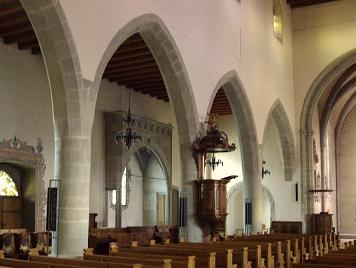
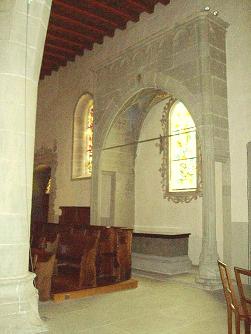
Our intrepid friend Catherine Minck has stopped at Payerne several times while traveling by train to Lausanne. She brought back pictures of the "chapel", a small stone structure on the inside of the church. The structure projects only a couple feet into the church and is recessed by a similar amount into the line of the exterior wall. Slender columns are surmounted by a small ribbed vault with a rosette bearing the arms and crest of the Gachet family. The façade of the chapel extends upward a few feet higher than the vault, but stops well short of the ceiling of the church. There is no evidence from the pavement of the floor that there could have been more than one or two burials here; the structure is simply too small. The style of the masonry, and the scale and form of the structure, do not appear to match anything else in the church, and we suppose that the chapel might have been constructed after the death of the one person supposed to have been buried there, Nicolas Gachet, Banneret of Payerne, who died in 1468.
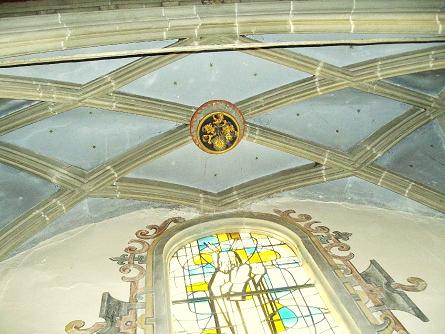
The rosette bears the same arms and crest as the window that was added in 1719, but the arms and crest do not match precisely. The rosette shows the sun with 16 rays (the same as the pew in Bern, dated 1668—however, the Gachet arms on this pew are a later addition, replacing some other carving, and the date might belong with the earlier, unknown carving—, and in the Wappenbuch of Nicolas Gatschet circa 1800), while the window shows 12 rays. The crest for both is a demi-lion rampant, but there are slight differences in the way the lion issues from the top of the helmet. Also, the shield on the rosette is notched at the side, while the shield in the window is entire. The rosette seems to include a small gold ring in the scroll work beside the shield, and there is an unexplained mark on the helmet. The gilding on the rosette is in good condition, but the blue ground of the shield and the scrollwork is now very dull. The Wappenbuch shows an entirely different crest, a swan. Do these details have any significance?
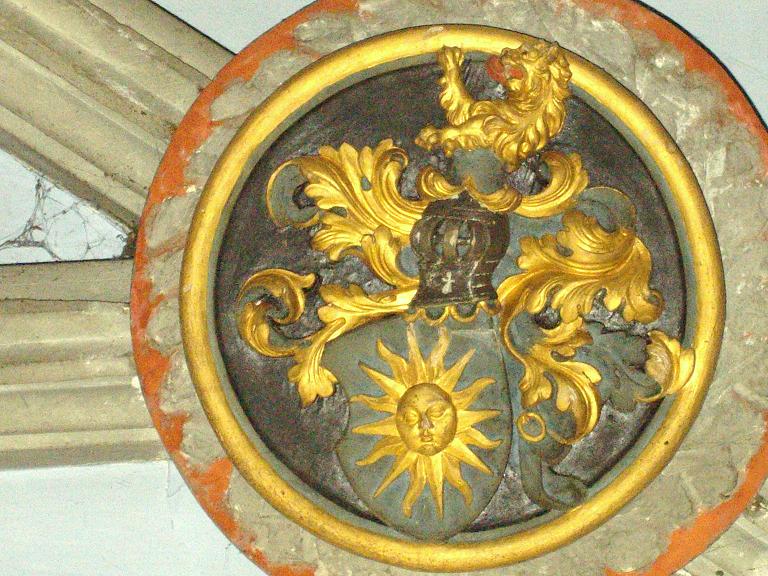
We suppose that the rosette is contemporary with the construction of the chapel. There was almost certainly a window in the original chapel, but it had probably been replaced by plain glass long before the Gachet window was donated by members of the Gachet and Gatschet families about 1719. The window may have been one of the artefacts that were lost when the city museum of Payerne burned about a half-century ago.
Revised May 8, 2009. — John W. McCoy.